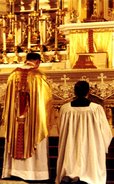In a news story in Il Giornale, Il Papa ai vescovi: via libera alla messa antica, they claim the following as being part of the Motu Proprio on the classical Roman liturgy:
1. "The text [of the Motu Proprio] declares that the ancient Roman rite has not been abolished"
2. The faithful will be able to directly approach the parish priest about celebrating the classical Roman rite. The role of the bishop is spoken of, but I can't make out the text. (A full translation would be good for anyone fluent in Italian.)
3. There will not be "two rites" but an "extraordinary" and "ordinary" form of the Roman rite. This is how it is spoken of.
4. The classical calendar and readings will be retained.
5. The MP pertains to all the sacramental rites as well in use in 1962.
6. The cover letter to the bishops explains that this is not a retreat into the past, or rejection of the Council; again, I find it hard to make out, but there is also something about liturgical rupture or 'fracture' as perhaps also not being the intention of the Council.
Update
[Taken from WDTPRS]
The solid Andrea Tornielli has a meaty piece in Il Giornale about the Motu Proprio.
Highlights:
1) The MP will be released probably on 7 July.
2) There will probably be no press conference to present the document.
3) The Pope offers a letter with the document to explain his decison.
4) The older rite was not abolished.
5) It had been decided by a group of cardinals in 1982 that there should be more use of the 1962 Missale.
6) The prayer about the "perfidis judeais" was already gone from that edition.
7) When "stable groups" ("gruppi stabili") want the older Mass they can go to the parish priest (pastor).
8) It will be the bishops role to help iron out problems, resolve difficulties.
9) The old calendar and readings for Mass are preserved.
10) People can have not only Mass but all the sacraments in the old rite.
11) We don’t speak any longer of two rites, of Paul VI and of "Tridentine", but of one rite of the Latin church in two forms, ordinary and extraordinary.
12) The Pope explains in his letter that this is not a return to the past.
13) What happened after the Council was not supposed to be a break with the past.
14) Mass must be celebrated well in either form.
15) Card. Castrillon Hoyos explained the text.
16) The Pope came and they discused things for an hour.
17) In the last few months very few and very small changes were made to the text, as was explained on Wednesday.
18) In the last few weeks Cardinal Lehmanand Cardinal Murphy-O’Connor brought up the point abut Jews being upset.
19) The French had expressed worry abou tht e "unity" of the Church, something they did not seem to wory about in the face of liturgical abuses in the Novus Ordo.
20) The Letter to the Chinese will be 28 pages.
21) The Pope declares the full validity of the sacraments celebrated by both the official and clandestine Churches.
Great article! Tornielli gets a thumbs up.



No comments:
Post a Comment